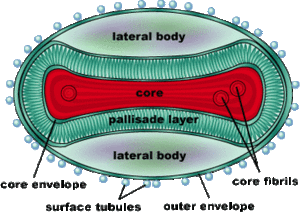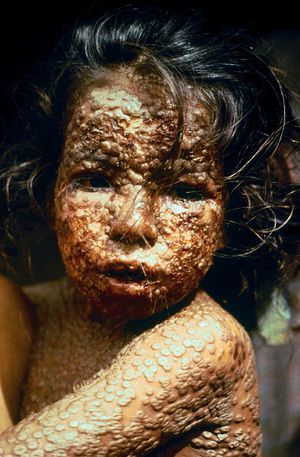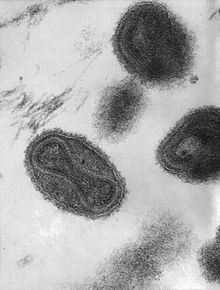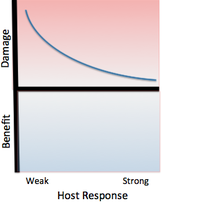Smallpox Virus: Difference between revisions
No edit summary |
|||
| Line 73: | Line 73: | ||
Website | 1. Website | ||
BT.CDC.GOV | BT.CDC.GOV | ||
CDC Smallpox | Smallpox Overview | CDC Smallpox | Smallpox Overview | ||
| Line 79: | Line 79: | ||
Bibliography: Bt.cdc.gov,. 'CDC Smallpox | Smallpox Overview'. N.p., 2015. Web. 28 July 2015. | Bibliography: Bt.cdc.gov,. 'CDC Smallpox | Smallpox Overview'. N.p., 2015. Web. 28 July 2015. | ||
2. Website | |||
Website | |||
EMEDICINE.MEDSCAPE.COM | EMEDICINE.MEDSCAPE.COM | ||
Smallpox: Background, Etiology, Epidemiology | Smallpox: Background, Etiology, Epidemiology | ||
| Line 86: | Line 85: | ||
Bibliography: Emedicine.medscape.com,. 'Smallpox: Background, Etiology, Epidemiology'. N.p., 2015. Web. 28 July 2015. | Bibliography: Emedicine.medscape.com,. 'Smallpox: Background, Etiology, Epidemiology'. N.p., 2015. Web. 28 July 2015. | ||
3. Journal | |||
Journal | |||
LANE, J. M. | LANE, J. M. | ||
Remaining Questions about Clinical Variola Major | Remaining Questions about Clinical Variola Major | ||
| Line 93: | Line 91: | ||
Bibliography: Lane, J. Michael. 'Remaining Questions About Clinical Variola Major'. Emerg. Infect. Dis. 17.4 (2011): 676-680. Web. 28 July 2015. | Bibliography: Lane, J. Michael. 'Remaining Questions About Clinical Variola Major'. Emerg. Infect. Dis. 17.4 (2011): 676-680. Web. 28 July 2015. | ||
4. Website | |||
Website | |||
WHO.INT | WHO.INT | ||
WHO | Smallpox | WHO | Smallpox | ||
In-text: (Who.int) | In-text: (Who.int) | ||
Bibliography: Who.int,. 'WHO | Smallpox'. N.p., 2015. Web. 28 July 2015. | Bibliography: Who.int,. 'WHO | Smallpox'. N.p., 2015. Web. 28 July 2015.http://www.bt.cdc.gov/agent/smallpox/overview/disease-facts.asp | ||
5. http://whqlibdoc.who.int/smallpox/9241561106_chp1_%28p1-p7%29.pdf | |||
6. http://www.bt.cdc.gov/agent/smallpox/training/overview/pdf/eradicationhistory.pdf | |||
7. http://whqlibdoc.who.int/smallpox/9241561106_chp3.pdf | |||
8. http://www.pnas.org/content/101/42/15190.full.pdf | |||
9. http://www.ncbi.nlm.nih.gov/pmc/articles/PMC3377426/ | |||
10. http://www.mediskin.cn/uploadfiles/file/20130726/20130726091251_0052.pdf | |||
Created by Danielle Lewis, student of Tyrrell Conway at the University of Oklahoma | Created by Danielle Lewis, student of Tyrrell Conway at the University of Oklahoma | ||
Revision as of 20:22, 28 July 2015

Taxonomy
Family: Poxviridae Genus: Orthopoxvirus Species: Variola major
Description

The variola virus is a rather large, rectangular shaped, double-stranded DNA pathogen. Unique from other DNA viruses, the variola virus replicates in the cytoplasm of parasitized host cells. Smallpox is capable of solely infecting humans and does not exist in a carrier state. The virus is capable of surviving in environments for a short period of time, and has maximum stability at low humidity and temperatures. Variola is most efficiently spread by inhalation and less effectively by direct contact with scabs or puss from infected skin lesions.
Pathogenesis
Smallpox is transmitted to the host via infection by the variola virus. The point of entry for the injection typically resides in the respiratory mucosa although the virus may enter through the skin. Upon infection the virus rapidly advances to the nearby lymph nodes. Following the 3rd or 4th day of infection the virus enters the blood and spreads to the bone marrow, sleep, and additional lymph nodes. Following the 8th to 12th day of virus in the blood, fever and toxemia occur. At this point the virus is localized in the blood vessels of the dermis as well as oral mucosa which leads to initial enanthem and exanthem. By day 14 the host is infectious and large amounts of virus are located in the kidneys, liver, spleen, lymph nodes, and bone marrow. Skin lesions initially develop from dilation of capillaries in the dermis as well as the swelling of endothelial cell vessel walls. These lesions spread to the epidermis where cells become swollen eventually increasing in size to the point of membrane bursting. Following vesicular lesions pus accumulates as a result of accumulation of polymorphonuclear cells into the vesicle. The pus eventually dissipates leading to scabbing of the legions. Death usually results from overwhelming toxemia most likely due to circulating immune complexes. Secondary infections can also induce a long-term effect such as encephalitis, blindness, and arthritis.
Transmission
Humans are the only natural hosts of the smallpox causing variola virus. Smallpox can be spread from person to person in a variety of ways. A common mode of transmission occurs with face to face contact for an extended amount of time. Other modes of transmission occur through the direct contact with bodily fluids and contaminated objects. In rare circumstances smallpox has been spread through the air or via the placenta. An individual injected with smallpox is highly contagious beginning with the onset of the fever and most contagious with the onset of the rash, they will remain so until the final smallpox scab falls off.
Epidemiology
The earliest clues to the emergence of smallpox come from mummified remains in ancient Egypt. Other early accounts of the disease stem from ancient medical writing from India, it is thought that the disease spread from region to region via the ancient trade routes in the east. Smallpox eventually spread to China and then Japan soon after, in one epidemic resulting in the loss of nearly a third of the population. Speculation exists on when exactly smallpox spread to Europe, with sporadic accounts during the time of the Roman Empire, it was not until the Crusades that the disease became well established in the growing population. In these early cases smallpox infected mainly children in many cases with a mortality rate of 30%. Smallpox was spread to the Americas via European exploration and colonization. The disease had a devastating effect on the Native American populations throughout the hemisphere. By the 18th century smallpox was a major disease in all parts of the world except Australia. Vaccination became widespread in the 19th century in Europe and North America reducing the seriousness of the outbreak. Later, a milder form of smallpox known as variola minor spread in the United States and South Africa becoming the dominant form of the disease and thus reducing mortality rates across the globe.
Virulence Factors
The variola virus is particularly successful at evading the host immune response via multiple virulence factors. The virus is a double-stranded DNA virus which contains an inner and outer envelope. The core membrane coats the core of the virus and contains lipids and proteins. The core itself contains large amounts of 186kbp DNA and around 10 enzymes for gene expression. Nucleoproteins involved in DNA transcription are also present. It has been determined that a complement-regulatory protein (CRP) exists in the variola virus. The CRP inactivates the host complement system by acting as a co-factor for serine protease factor I. This is done by cleaving C3b and C4b and will protect the host cell from being attacked by the complement cascade. The virus also has the ability to use fusion proteins to fuse out of the host cell which exposes them to extracellular material and promotes degradation.
Clinical Features and Diagnosis

Early symptoms of smallpox include:
-fever (101 to 104 F)
-malaise
-head and body aches
-vomiting (in some cases)
Further symptoms as the virus progresses:
-rash emerges as red spots on tongue
-red spots becomes sores and burst
-rash appears on skin starting on face and moving to arms and legs then hands and feet
-rash spreads to entire body in 24 hours
-fever subsides and host begins to feel better
-third day of rash becomes bumps
-fourth day bumps become filled with fluid
-fever returns and remains high until bumps scab over and subside
Later states of the virus consist of:
-bumps become pustules
-pustules begin to scab
-scabs become pitted scars
-most scabs fall off three weeks after rash appears
Smallpox may be identified via growth of chicken embryo and examination of pock lesions under specific temperatures. In addition, PCR analysis may allow for a definite determination.
Treatment
The primary treatment available for smallpox is the smallpox vaccination. Depending on the amount of days administered following infection, the vaccine will reduce the severity of the disease and offer protection. In addition to vaccination other supportive treatment for smallpox is available such as treatment for sores and fluid therapy. There is no approved drug for smallpox.
Immune Response
The host immune response is relatively unsuccessful in defeating the smallpox infection. The host attacks the variola virus through FN, cell-cycle proliferation, and TNF-alpha and NFk responses. An early antibody and plasma cell response also contribute to prolonged survival of the infection. For the most part T cells and B cells are unsuccessful in mounting a strong immune response as their lymphocyte numbers take a notable decrease over the course of the infection.
Damage Response Framework
The smallpox virus would be classified as a Class 2 pathogen according to the Damage Response Framework classification system. Smallpox is classified as a Class 2 pathogen due to the strong response of host cells in the setting of normal host immune responses and the more severe damage in host cells with a weaker immune response such as in children and pregnant women.
Socioeconomic Impact
The first appearance of smallpox lesions were found from Egyptian mummies including Pharaoh Ramses V who died in 1157 BC, although it is believed to have first invaded the earth around 10,000 BC. The first recorded epidemic of smallpox was in 1350 BC. The World Health Organization officially announced the world clear of the smallpox virus in 1980. This was the first disease to be eradicated by scientific effort. Throughout the twentieth century, smallpox killed 300-500 million people with the survivors being left severely scared or blinded. Smallpox killed twice as many people as genocide, war, and famines total did throughout the twentieth century. Twenty to sixty percent of the population who was infected died from the disease and this percent increases to 80 when talking about children. It is hard to measure the full impact a 12,000 year old disease has had on the human population. Current issues with smallpox are whether or not the disease should be destroyed and not contained in a freezer of a laboratory.
Eradication
The first notable efforts to eliminate smallpox were attempted by Edward Jenner in the 1700s demonstrating how effective cowpox could prevent an infection. Upon development of a vaccine widespread vaccinations began in global powers throughout the 1800s. The mandatory use of the vaccine spread from country to country throughout the century. With the coming of the 1900s global health powers stepped up their efforts to spread the vaccine to less developed countries with the elimination of the disease from nearly the entire western hemisphere in the 1950s. Stating in 1958 and intensified in 1967 the World Health Organization (WHO) stablished a variety of programs to finish off the virus. Vaccinations continued until the only widespread reporting of cases existed in the Horn of Africa. 1977 and 1978 were the last years of recorded cases on smallpox in humans. Finally in 1980, the WHO declared an official end of smallpox from the globe.
References
1. Website BT.CDC.GOV CDC Smallpox | Smallpox Overview In-text: (Bt.cdc.gov) Bibliography: Bt.cdc.gov,. 'CDC Smallpox | Smallpox Overview'. N.p., 2015. Web. 28 July 2015.
2. Website EMEDICINE.MEDSCAPE.COM Smallpox: Background, Etiology, Epidemiology In-text: (Emedicine.medscape.com) Bibliography: Emedicine.medscape.com,. 'Smallpox: Background, Etiology, Epidemiology'. N.p., 2015. Web. 28 July 2015.
3. Journal LANE, J. M. Remaining Questions about Clinical Variola Major In-text: (Lane) Bibliography: Lane, J. Michael. 'Remaining Questions About Clinical Variola Major'. Emerg. Infect. Dis. 17.4 (2011): 676-680. Web. 28 July 2015.
4. Website WHO.INT WHO | Smallpox In-text: (Who.int) Bibliography: Who.int,. 'WHO | Smallpox'. N.p., 2015. Web. 28 July 2015.http://www.bt.cdc.gov/agent/smallpox/overview/disease-facts.asp
5. http://whqlibdoc.who.int/smallpox/9241561106_chp1_%28p1-p7%29.pdf
6. http://www.bt.cdc.gov/agent/smallpox/training/overview/pdf/eradicationhistory.pdf
7. http://whqlibdoc.who.int/smallpox/9241561106_chp3.pdf
8. http://www.pnas.org/content/101/42/15190.full.pdf
9. http://www.ncbi.nlm.nih.gov/pmc/articles/PMC3377426/
10. http://www.mediskin.cn/uploadfiles/file/20130726/20130726091251_0052.pdf
Created by Danielle Lewis, student of Tyrrell Conway at the University of Oklahoma


